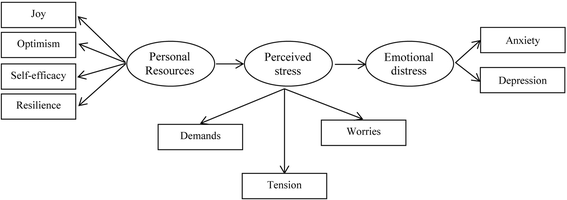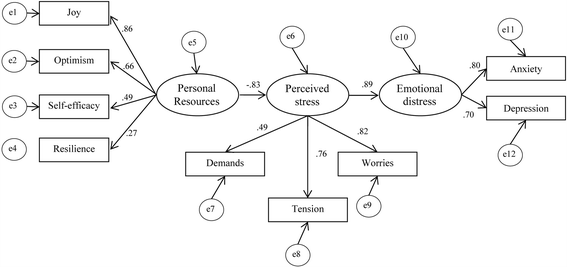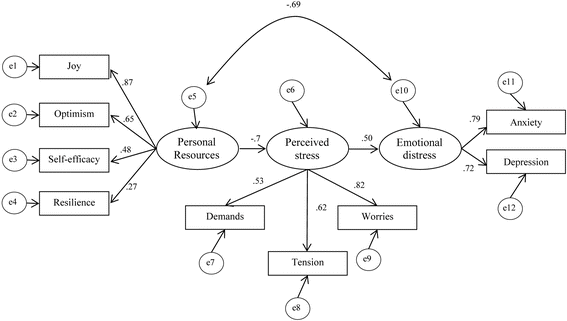Perceived stress in first year medical students - associations with personal resources and emotional distress
- PMID: 28056972
- PMCID: PMC5216588
- DOI: 10.1186/s12909-016-0841-8
Perceived stress in first year medical students - associations with personal resources and emotional distress
Abstract
Background: Medical students have been found to report high levels of perceived stress, yet there is a lack of theoretical frameworks examining possible reasons. This cross-sectional study examines correlates of perceived stress in medical students on the basis of a conceptual stress model originally developed for and applied to the general population. The aim was to identify via structural equation modeling the associations between perceived stress and emotional distress (anxiety and depression), taking into account the activation of personal resources (optimism, self-efficacy and resilient coping).
Methods: Within this cross-sectional study, 321 first year medical students (age 22 ± 4 years, 39.3% men) completed the Perceived Stress Questionnaire (PSQ-20), the Self-Efficacy Optimism Scale (SWOP) and the Brief Resilient Coping Scale (BRCS) as well as the Patient Health Questionnaire (PHQ-4). The statistical analyses used t-tests, ANOVA, Spearman Rho correlation and multiple regression analysis as well as structural equation modeling.
Results: Medical students reported higher levels of perceived stress and higher levels of anxiety and depression than reference samples. No statistically significant differences in stress levels were found within the sample according to gender, migration background or employment status. Students reported more self-efficacy, optimism, and resilient coping and higher emotional distress compared to validation samples and results in other studies. Structural equation analysis revealed a satisfactory fit between empirical data and the proposed stress model indicating that personal resources modulated perceived stress, which in turn had an impact on emotional distress.
Conclusions: Medical students' perceived stress and emotional distress levels are generally high, with personal resources acting as a buffer, thus supporting the population-based general stress model. Results suggest providing individual interventions for those students, who need support in dealing with the challenges of the medical curriculum as well as addressing structural determinants of student stress such as course load and timing of exams.
Keywords: Anxiety; Coping; Depression; First year medical students; Joy; Optimism; Self-efficacy; Stress.
Figures



References
-
- American Institute of Stress. What is Stress? [http://www.stress.org/what-is-stress/] Access Date 26 Aug 2016
-
- Lazarus RS, Folkman S. Stress, appraisal, and coping. New York: Springer Publishing Company; 1984.
-
- Antonowsky A. Health, stress, and coping. 1. San Francisco: Jossey-Bass Publishers; 1979.
-
- McGuire FL. Psycho-social studies of medical students: a critical review. J Med Educ. 1966;41(5):424–45. - PubMed
MeSH terms
LinkOut - more resources
Full Text Sources
Other Literature Sources
Medical

